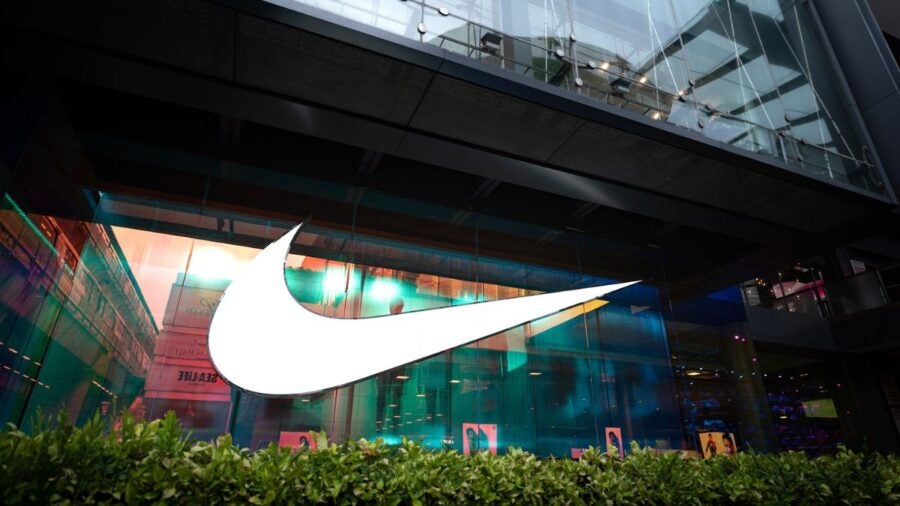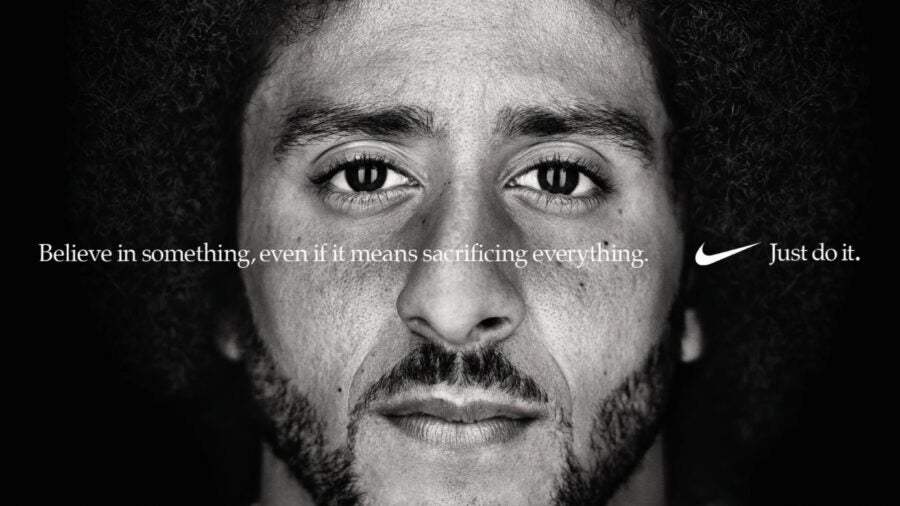
Step onto any pitch, court, track or city street and you will likely see a Nike ‘swoosh’. As the sportswear giant celebrates its 60th anniversary this week, it does so as one of the world’s most ubiquitous and valuable brands.
Nike clothes are still principally made to enhance sporting performance. In 2024, the swoosh is worn by some of the world’s top athletes and teams. But now Nike is as fashionable as it is functional. Indeed, there is arguably no company more attuned to the athleisure trend.
Nike makes cool and innovative products. But the company’s global success and status, in the main, comes down to a multi-layered marketing strategy, which any business can learn from.
An iconic yet simple logo
The swoosh was created in 1971 by Carolyn Davidson, a graphic design student at Portland State University, where Nike co-founder Phil Knight was teaching accountancy at the time. The single-motion, angled tick became the centrepiece of Nike when it rebranded from its original name, Blue Ribbon Sports, after seven years.
Manfred Abraham, the chief executive of business consultancy Yonder, believes the swoosh is one of Nike’s most valuable assets, in part because it is “simple yet slick”. The advantage of having a small, unobtrusive logo, he says, is that it can be used in lots of different places, from shoes to clothing, to billboards and mobile phones. “It doesn’t take long to replicate, so you can make sure it gets seen a lot, and it doesn’t need a lot of surface area,” he says.
Another benefit is its longevity. Because Nike has had the same logo since 1971 it has been able to use it to build brand awareness over a long period of time. “More complicated logos often have to be updated or adapted, particularly in the digital age,” says Abraham.
The logo also succeeds, he believes, because it can be associated with the products the company is selling and the message it is trying to put across. “A tick makes you think of success and achievement,” Abraham notes. “Nike is all about performance. You can take that association with sport and then apply it to the rest of your life.”
A slogan for the consumer, not the company
Nike’s famous ‘Just Do It’ slogan, was born out of an advertising meeting with its agency Wieden+Kennedy in 1988. It was, according to the agency’s co-founder Dan Wieden, inspired by the final words of a death row inmate.
Nike’s interpretation of the words, of course, have quite a different meaning. Daisy Proctor, managing director of creative branding agency BBD Perfect Storm, says the slogan is effective because Nike has chosen to speak directly to the consumer, rather than opting for a message that says something about the company.
“Nike has this idea that anyone can be an athlete,” she says. “The slogan is encouraging people to just get out there and take action. It’s not saying you have to go and be a professional. The ‘just’ is saying that you shouldn’t let anything stop you.”
She also notes that the slogan is easy to remember. That means it can achieve powerful cut-through among consumers: meaning they notice and remember it. “The most successful brands are the ones that embed themselves in people’s everyday lives. If people remember Just Do It slogan and its association with inspiration, that’s going to help Nike always be associated with hard work or success,” she says.
Celebrity endorsements
Over the years, Nike has brokered numerous athlete endorsement deals. Athletes are carefully selected based not only on their sporting prowess, but also on whether or not they have an interesting story to tell and whether they align with the Nike brand values.
Michael Jordan is the best example of this. The basketball star had an entire line of shoes and clothing built around him, Air Jordan, which remains one of Nike’s best-selling lines despite Jordan’s retirement.
When advertising Air Jordan sneakers, Nike again adopted a consumer-centric approach. The 1991 ‘It’s gotta be the shoes’ commercial suggested that wearing Jordan’s line could help people to play better basketball.
But, Proctor points out, Jordan wasn’t a global star when he signed with Nike. For her, there is a lesson for CMOs to try and think about potential. “Risks should be calculated, but you do need to take some,” she advises.
Local adaptations based on different audiences
Another reason for Nike’s success is that while it is a global brand, it is still sensitive to local nuances. In 2014, for example, the company launched an India-specific campaign, ‘Make Every Yard Count’, that collated footage of 1,400 amateur cricketers.
In Europe, Nike might have used football but in India it focused on a sport that was more popular in south-east Asia. The Just Do It slogan, however, was still used in the advert to convey a sentiment of innate possibility to an aspirant population of 1.4 billion people.
Abraham believes Nike is very good at striking a balance between both its elite and everyman identity. When targeting a new market, or different consumer base, potentially with different budgets, Nike will tailor its marketing strategy. “The story or message is the same. That’s achievement and performance,” he says. But, for Abraham, it is crucial to ensure that campaigns are relevant and relatable to the audience they are being shown to.
Taking a stand on social causes
When it comes to politics or cultural debates, Proctor suggests that companies which take a position of “brand-neutrality” do so at their peril. Increasingly, consumers care about where and how they spend their money, so expectations of brands’ environmental and social impact are rising.
Nike has taken this idea to heart. It supported the Black Lives Matter movement through its ‘Dream Crazy‘ campaign by featuring Colin Kaepernick, who was criticised for kneeling during the American national anthem in protest at racial injustice in the United States. It sign-posted Nike as an unabashed advocate for diversity and inclusion even if it could potentially alienate some consumers, which in turn gave the impression that purpose mattered as much profit.

“Consumers want meaningful brands,” Proctor explains. “It’s important that there’s some credibility to what’s being said and that a company speaks authentically. Nike did that, for example, by really supporting Colin Kaepernick and the take a knee gesture. Nike didn’t just post a tweet, it made this a central part of its advertising campaigns. That was a risk, but it paid off.”
Nike’s commitment to social causes and community projects, Abraham adds, contributes to why it arguably enjoys a more favourable cultural perception than other multi-billion-dollar brands. “There is one central philosophy that underpins all of its strategy, including marketing,” he says. “The company is very clear about what it stands for: it shouldn’t matter what background you have, you, as a human, should be able to perform.”
A marketing masterclass
Nike is ultimately good at marketing, Proctor says, because it is good at storytelling. Over the past six decades its campaigns have been characterised by tales of human beings achieving extraordinary things.
CMOs in any industry, then, should learn from Nike. If a brand can make the consumer feel that it genuinely believes in what it is doing and saying, and if it can make the consumer feel like buying a particular product or service is actively going to improve their lives, it’s more likely to succeed.
As Nike demonstrates, though, it helps if the product or service looks cool, too.
What marketers can learn from Nike’s success
Take a look at your logo. A great logo is simple yet distinctive, appropriate, practical and conveys the company’s intended message. Is it obvious what the logo is? Is it easy to replicate? Does it work on different platforms, such as social media channels?
Say your slogan out loud. Companies can benefit from framing the narrative around the consumer, rather than themselves. What significance can your brand have in someone’s life? Does this slogan inspire or intrigue?
Consider who your audience is. Firms should make sure messaging is relevant, relatable and aligned with cultural expectations. Is your campaign aimed at delivering a positive change? Will this product or service improve people’s lives?

Step onto any pitch, court, track or city street and you will likely see a Nike ‘swoosh’. As the sportswear giant celebrates its 60th anniversary this week, it does so as one of the world’s most ubiquitous and valuable brands.
Nike clothes are still principally made to enhance sporting performance. In 2024, the swoosh is worn by some of the world’s top athletes and teams. But now Nike is as fashionable as it is functional. Indeed, there is arguably no company more attuned to the athleisure trend.
Nike makes cool and innovative products. But the company’s global success and status, in the main, comes down to a multi-layered marketing strategy, which any business can learn from.





